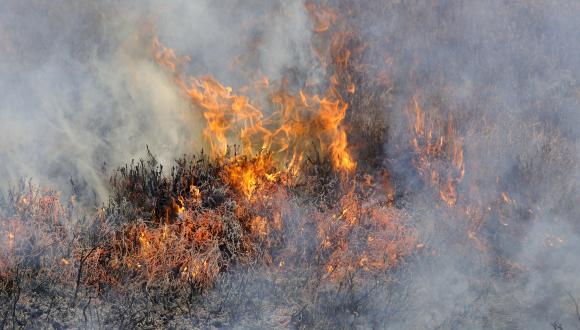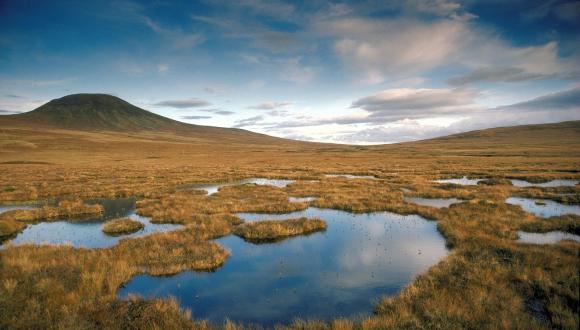Restoring Scotland's Peatlands
More than 20% of Scotland is covered by peat – and keeping our peatlands healthy is vital to tackling climate change.
Scotland’s National Peatland Plan highlights the major contribution peatlands make to our landscapes, and cultural and natural heritage. Many of our iconic views are framed and coloured by peatlands, from the vast expanses associated with the north Highlands and Islands of the west of Scotland to the bogs and fens just a short distance from most of our towns and cities.
These areas add much more than dramatic scenery, they provide a special and unique habitat for wildlife and are an essential ingredient for farming, tourism and crofting.
More than 20% of Scotland is covered by peat and much of our drinking water filters through these peatland catchments making them crucial for clear drinking water. Peatlands also hold most of Scotland’s carbon store (they are estimated to hold the equivalent of 140 years’ worth of Scotland’s total annual greenhouse gas emissions), and so are vital in helping us to tackle climate change. Healthy peatlands provide many benefits to us all – but not all of our peatlands are in good health. It is estimated that 80% of Scotland's peatlands are damaged.
Healthy peatlands:
- benefit biodiversity – as an internationally important wildlife habitat;
- regulating atmospheric pollutants - by absorbing pollutants such as sulphur dioxide, nitrogen and heavy metals;
- improve water quality – by reducing the amount of carbon in water, which results in water discolouration and requires extra treatment before it comes through our taps;
- reduce flooding – by regulating run-off and maintain base flows in upland streams during dry spells;
- support our economy – whether used in farming, tourism or crafting, or by indirectly benefiting whisky production and fisheries;
- shape our landscapes – enabling recreation and improving our quality of life;
- reveal our past – pollen, plant and insect remains can be studied to tell us about past changes in climate, environment and vegetation.
Degraded bogs emit carbon dioxide and other greenhouse gases, which contribute to climate change. To prevent damage, overgrazing and practices that require drainage of peatlands must be avoided.
Restoring peat-forming habitat previously drained or damaged by re-wetting and ultimately reconnecting peatlands to their catchments ensures that the bog remains a long-term carbon sink rather than a greenhouse gas source.
Land managers can learn how to assess the health of peatlands using the Peatland Condition Assessment support tool
Types of peatland habitat
There are four main natural peatland habitat types in Scotland: blanket bog, raised bog, fen and bog woodland. Although all supported by peat, and there are some intermediate forms, generally they are quite distinctive in terms of their vegetation, hydrology, place in the landscape, nutrient status and, to some degree, geographical distribution.
Blanket bog is only found in a few parts of the world with cool, wet and typically oceanic climates. Under these conditions bog mosses and other plants break down very slowly and gradually form a layer of peat. Peat depth varies, with an average between 0.5 and 3 metres deep, but depths of up to 8 metres are not uncommon.
Found throughout the Scottish uplands, blanket bogs are most extensive in the north and west in areas with gentle slopes and poor drainage. They are dominant over the gently undulating moorlands, particularly in the North Highlands and Western and Northern Isles.
Blanket bog covers some 1.8 million hectares, 23% of our land area. Rare globally, Scotland holds a significant proportion of the European and world resource. It also supports some of our rarest and most threatened wildlife, including internationally important breeding bird populations.
It is also our largest terrestrial carbon store, holding around 1.6 billion tonnes of carbon. Ensuring that this carbon is secure, and enhancing its capacity to store more even more carbon, are among the highest priorities for this plan.
Raised bogs are found mainly in the lowlands. In their natural state, these appear as domes growing to 10 m or more in height, with the growing dome being ‘fed’ by rainwater. The surface is waterlogged, acidic and lacking in nutrients. Vast areas have been lost to agricultural, horticultural and forestry practices.
Fens are special places where nature and centuries of human activity combine to produce a rich and ever-changing habitat. Scotland supports a wide variety of different fen types, ranging from tiny fragments to extensive mosaics of wetland habitats at a landscape scale. Once highly valued for their products, their use within social and agricultural systems declined with the advent of intensive agriculture, drainage and mechanisation.
Bog woodland is one of Scotland’s rarest habitats, with a limited range. Scots pine is the main tree species present, but other trees such as birch and willow occur. The underlying vegetation is often similar to that of open bog. As these woods can be hard to get into, they are often un-managed and probably represent some of our most “natural” native woods, with a truly wild feel to them.
A range of other semi-natural wet woodland types can occur on peatland and should be recognised for the biodiversity and other benefits they provide.
Restoration funding:
The Scottish Government has invested more than £30 million in Peatland ACTION and over 25,000 hectares of previously damaged peatland habitat have benefited directly from restoration activities.
This good work is continuing thanks to the Scottish Government’s pledge in 2020 to invest more than £250 million over 10 years. This multi-annual investment will help deliver peatland restoration activities through a number of partners in public, private and third sectors, part of which is co-ordinated by NatureScot through Peatland ACTION.
PeatlandACTION also offers videos and posters that share our lessons learned from setting up and running practical peatland projects across Scotland.
We continue to offer advice on applications for the Agri-Environment Climate Scheme (AECs). Peatland restoration management options available through AECS, include moorland management, lowland bog management, and management of buffer areas for fens and lowland bogs. AECS also offers capital payments for works such as ditch blocking.
Peatland ACTION is helping to restore damaged peatlands across Scotland. We have knowledgeable and dedicated project officers who can help you with your proposed Peatland ACTION project or Feasibility Study - please email the PeatlandACTION team to speak to one of our advisors.







